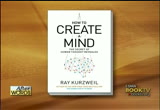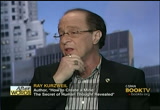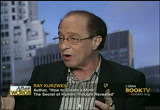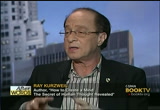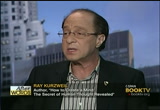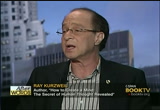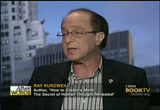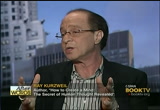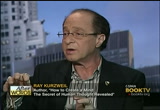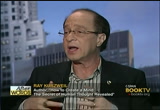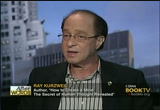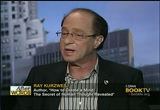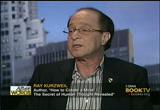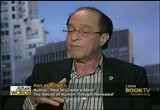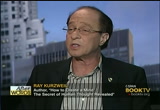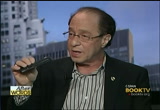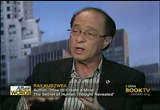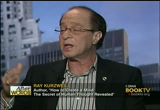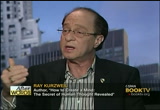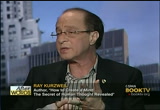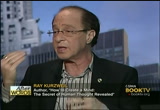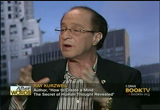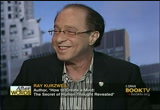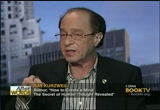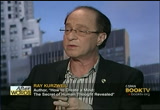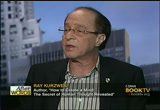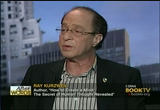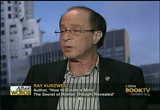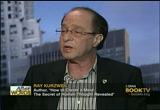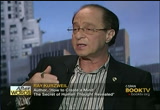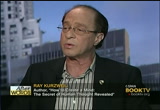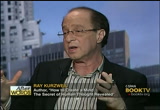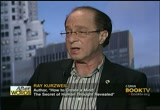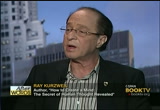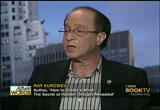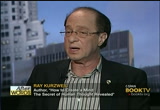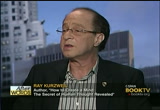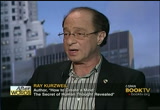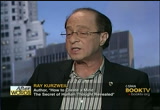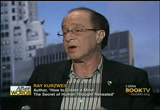tv Book TV CSPAN December 25, 2012 11:00am-12:00pm EST
11:00 am
11:01 am
c-span2. >> coming up booktv presents "after words," an hourlong program where we interview authors. acclaimed inventor ray kurzweil and his latest book, how to create a mind:an exploration of reverse engineering of the brain. the national medal of technology recipient attempts to determine how the brain works and apply the knowledge to the creation of intelligent michelin's. to discuss his research with the editor of scientific american mind, . to discuss his research with the editor of scientific american mind,achines . to discuss his research with the editor of scientific american mind,. to discuss his research with the editor of scientific american mind, ingrid wickelgren. >> this is a fascinating book and it is great to be with you. my first question is to try to talk about the main thesis of the book. are you saying that we can basically reverse engineer the
11:02 am
human brain, that it is feasible to do that to creates computer mind that is in distinguishable from yours and mine? >> it is feasible. the level of complexity we can handle, i actually describe the basic principles of the neocortex in the book. some people say and i articulate this criticism in the book and respond to it that every one of the hundreds of trillions of connections was placed exactly where it needs to be and that is impossible. the areas with design information, there are only twenty-five million bake of design information for the genome in the brain. and only trillions of connections so there's a lot of repetition. certain design principles that are repeated over and over again. in particular the main thesis is we have three hundred million that are basically using the same algorithm and these pattern
11:03 am
recognizers connect themselves and higher key and the neocortex is capable hierarchical thinking. we can develop these ideas more but that is the emphasis of it. they are basically running the same method and the secret is the ability for each of these pattern recognizers to build a hierarchy with other recognizers. at the low level we are recognizing simple things like a capital a. and on higher level you recognize the capital a and higher level the apple and much higher bubble that was funny, that was ironic. these pattern recognizers are all basically the same except for their position in the hierarchy. where does this hierarchy come from? we are not born with it. language is a hierarchy replacing the hierarchical structure of the neocortex. we are not born with a knowledge of english or chinese.
11:04 am
all of these connections that reflect our knowledge, our memories, skills and personality, we create, the neocortex creates from our own experience so you are what you eat but more importantly you are what you think. your grandson has laid down several layers now of this conceptual hierarchy. we basically can work on one layer at a time. >> host: the layers are said to some extent by biology, genomics information so it is a combination of things. >> guest: the ability to create the layers is there but a newborn is struggling with understanding the very basic sounds and shapes and touch and is laying down the most basic level of this hierarchy. the reason a child can learn
11:05 am
material like a new language so easily is we have three hundred million of these pattern recognizers, we have filled them up by the time we are 20. it doesn't mean you can't learn new things. anything we have learned, i don't just have one copy of that, i have hundreds or thousands. i can give up some of the redundancy to learn new material. i can give up old memories altogether which is why we find old memories fading if we don't revisit them. we do have the ability to guess old patterns and learn new ones, some people are better at that than others but that is one reason a child can learn so readily futz -- the neocortex. the hierarchy it creates with our own experiences. the process of learning, the
11:06 am
interactions we have with the whole world is a very important part of the development, you could do a perfect job with the neocortex and it wouldn't do anything useful just like a newborn is limited in skill, without an education or supporting the paradigm for a i, artificial intelligence, to educate them. >> host: can you elaborate on what the neocortex is as opposed to the brain? >> guest: the old brain and the new brain. the new brain is the neocortex. only mammals have the neocortex. these early mammals emerged over 1 hundred million years ago, the neocortex is the size of a postage stamp and is basically the outer layer, neocortex means
11:07 am
new rind, of the brain and capable of thinking in a hierarchical fashion. >> host: that is the part of the brain you are focusing on. >> caller: -- >> guest: it has complexity 2. twenty-nine and change quickly they were able to adapt. that was not so much an advantage because the environment did not change quickly. it is the normal process of biological evolution, changing behavior over thousands of generations. it is good enough for non medallion species until the cretaceous extinction event sixty-five million years ago. we see geological evidence of it everywhere in the world, something dramatic happened to change the environment suddenly sixty-five million years ago. there are theories about it having to do with a meteor but we do know the environment
11:08 am
changed. thousands of these non minnelli and species who could not adapt very quickly died out and that is when mammals became prominent in their ecological niche. anthropomorphize biological evolution and said it started -- as mammals evolved. by the time you get to primates it is no longer just a plant covering in the brain, it has all these convolutions. you are familiar with what the brain looks like. to expand its surface area. in the human or any primate it has all these fissures and curves. you can stretch out in theory and make a flat sheet, it is still fin and still the outer layer but comprises 80% of the brain. it is where we do our hierarchical thinking. we still have the old brain that
11:09 am
provides motivation, fear, aggression, sex drive, pleasure but they are modulated by the neocortex, think of it as a bureaucracy that can take a long time to write a poem, but only primates have the ability to do that at a high conceptual level. the major innovation in homo sapiens is a large forehead to allow more neocortex. we have a frontal cortex. that is greater quantity with the enabling factor that permitted the evolution of language and technology intervention and art and science. which no other primate has done. there are simple examples of primates creating tools or using language but not in this indefinitely expanded hierarchical fashion that humans
11:10 am
do. >> host: you are thinking of the main functions of the neocortex as high level functions such as decisionsmaking, inhibiting improper action, not so much -- see neocortex as a huge number of things. >> guest: it does lots of things that high and low levels using the same algorithms. lot of pattern recognizers like the edges of objects or the capital wa and all these primitive functions. it is a high-level conceptual hierarchy. one powerful piece of evidence that came out as i was sending this to the publisher is what happens to the region of the neocortex ready optic words ago? it is very primitive pattern
11:11 am
like the edges of objects. it is low level, very simple pattern. what happens to it? a blind person who is not getting any visual information, actually gets taken over by the frontal cortex to help process high-level language concepts. here is the same region doing low-level concept handling high level concepts showing that the algorithm is the same and the difference is the conceptual hierarchy. the hierarchy is created by the neocortex itself. there are actual physical connections connaught axons and dendrites that connect three hundred billion modules. we start with a wiring pattern that allows different modules to connect to each other which exists in another grid, a recent piece of evidence shows very
11:12 am
orderly grid pattern of streets and avenues so two modules want to connect to each other because it is a higher level concept than this one and this pattern recognizers wants to feed the concept to a higher level, there is an avenue and a street that will connect those two and basically finishes the connection for that process in real time in a living brain. we create this hierarchy and there is an interchange ability. >> host: you are talking about some fancied details, imaging data that shows what the connections are that are very regular. >> guest: initially they are very regular to allow these connections. some of them don't get used. half of them are turned away like a newborn has because they
11:13 am
actually get connected with actual hierarchy that we laid down through our experience. basically it starts with the potential of developing this hierarchy, starts at the lowest level of the hierarchy, the fetus's eyes, embryos, those patterns of light and dark, starting to develop the neocortex layer by layer. even as adults we have to learn the prerequisite before we can learn new subject material but we have the added challenge to get something because the neocortex is filled the. the idea that we use 10% of the brain is not correct that some people have created this hierarchy of the neocortex in a new -- more useful fashion than
11:14 am
others for particular tasks. einstein had it very well organized for doing physics, beethoven and it will organize for music and so on. >> host: back to the importance of learning and how computers learn, i wanted to ask you, why do we want to create reverse engineer the brain? why do we want to create this computer software brain? >> guest: three reasons. one is too a better job fixing of the brain. i quote one of the pioneers saying we're treating brain circuitry rather than a chemical soup. something like this as our i s --sri drugs treating the brain like a chemical soup. is really a network. as we understand how it works we
11:15 am
can do a better job fixing problems. secondly it will provide biologically inspired method to create more intelligent machines. some intelligence in machines whenever we do a search or translate from one language to another, self driving cars, phones you can talk to that talk to the clout and answer questions not perfectly but getting better every week, intelligence is very helpful, it will help solve a major challenges of humanity and we will ultimately expand human intelligence which we are doing already. part of my brain went on strike because i am so dependent on these. the third reason is to fulfil the purpose of art and science which is to know ourselves, to better understand ourselves, to understand how the human brain
11:16 am
works and how the neocortex works and how it interacts with the old brain which provides primitive motives, fear and aggression. we will understand ourselves better. that is the goal. >> host: if we make a replica of the human brain in a computer we might be able to have a new perspective on certain philosophical questions such as free will or consciousness? >> guest: i talk about consciousness and free will and identity in the book and those are questions which some people say is not scientific, not real but i would not be so quick to dismiss them because the core concept of morality in the legal system is based on consciousness and free will. it gives us greater insight into everything, into what is important and how human beings work but ultimately will help us
11:17 am
to actually become more intelligent. we are already a human machine, ever since we could reach that piece of fruit at higher branch, we fashioned tools to extend our reach. starting with simple physical tools and an extended our reach mentally and we literally expand our intelligence with these machines. the best way to do that is understand how the human brain does it. than we can implement it in a way that doesn't have limitations of biology. the circuitry in the cumin brhun transmits information using electrochemical signals which travel million times slower than an electrical signal. it is ten million times slower than a computer. ultimately we could create systems that are much more
11:18 am
powerful. i view those asked not assistance -- it does not tell us about intelligent machines. we are a machines civilization and make ourselves smarter which we are already. we are so dependent on these tools which didn't even exist a few years ago. >> host: that is amazing. can you talk a little bit more about the forms that these new human like machines will take? are we talking little national box in the bloodstream or software in the cloud? >> guest: the first form looks like this. if you doing anything interesting with this like asking a question and have a translate, it doesn't actually take place in this rectangular box listed goes to the cloud. ultimately when we do put intelligent machines in our
11:19 am
bodies and brains the action will take place in the cloud. they will be gateways to the cloud. >> host: there will be something inside me going around transmitting to the cloud? >> guest: we interact with devices which are getting smaller and smaller. as they get smaller we don't want to be looking at a postage stamp size screen. the next stage is not going inside the body and brain but putting displays in your glasses which will come out where you basically have all the visual reality as you screen. it could just be a screen or all kinds of reality. just knowing what someone's name is will be a killer apps and guide us through the day. these systems will become intelligent. to wait to be asked, they will see struggling with something and the way you will see it is listening in on everything you
11:20 am
are doing. everything you write, everything you read, everything you say, everything you hear. if you let it and i believe you will let it because it will be a very useful assistance. >> host: does it scare you? >> guest: it would be great. if something pops up, just yesterday you were wondering about how to get a supplement into the bloodstream. research came out 24 minutes ago that addresses that question or that access you were trying to find this morning and information about it, in the middle of a conversation, google something, it is a pain to even do that. should be listening in like a friend and realize you need a particular piece of information. he would be frustrated if it didn't immediately popped out because it should know what i
11:21 am
need. >> host: all our thoughts are not factual things. some of them are things we would rather keep to ourselves? >> guest: the intelligence is going to grow gradually. search engines right now don't even really read all these documents, these search engine, google spiders crawled web and analyze documents based on their words, a little bit of conceptual analysis that basically not really reading for content. that is going to change. they will read billions of documents and millions of books and there's a lot of useful information embedded in the semantics of what is on there which is why they were written. the assistant should understand that and the fact that that is feasible shown by watson, people realize the information watson has in the jeopardy game was not
11:22 am
hand coded into computer language. it actually read wikipedia and other encyclopedias. 200,000 pages of unnatural language documents. it does not do as good a job as you would do reading a page. you could read one page and say 97% chance barack obama is president if you didn't know anything about it and watson would read the same page and go there is a 56% chance barack obama is president. it did not do as good job but it has read two hundred billion pages and may be 100,000 -- >> host: a computer that -- [talking over each other] >> guest: it is within three seconds can access all of the knowledge in those two hundred billion pages at its level of understanding. even though that level is below human, the scale is beyonce human. we can't read that many pages
11:23 am
and remember it all. if we can even get through it. that level of understanding is going to gradually get better. my contention is by 2029 it will surpass human intelligence and read billions of pages. watson is the adapted to read medical journal articles and be a medical diagnostician and consulting system that will read everything, doctors can't read everything. articles come out every day. that is where we are headed. >> host: we will have the software systems that will exist in multiple forms, independently as well as things that can communicate with us and talk to us. it will be more human like in thinking. >> guest: more integrated in our field of view so we don't actually have to interact with a a little box. it will be more seem less than
11:24 am
that and eventually go inside our bodies. that is not tomorrow. that is decades away. another one of the trends i talked about in my previous book the singularity is near, information technology is progressing exponentially. performance and size, they are shrinking and the rate of 150 volumes per decade. these will be blood cell size in 2013s 42040s. we will put them in our blood stream to keep us healthy but they will go inside the brain, act as biological neurons, just to put those biological neurons as gateways to the clout and we can expand beyond three hundred billion pattern recognizers we have. one question is is that a lot for a little? it was a lot compared to other mammals so it enabled us to create art and science and
11:25 am
technology but is little compared to what it is like because if you think about the leads we had with this extra frontal cortex was an enabling factor for this qualitative leap of creating language and science to think what qualitative leaps we can make with the next expansion. >> host: quickly, we have a little bit of time before the break, could you tell us how this book goes beyond your previous book the singularity is near? many people read that book. >> guest: i had one chapter on the brain. a lot was to make the point that our knowledge is expanding exponentially which it was, but even at that point, we were far from being able to actually see individual connections in the brain. facial resolution and brain scanning progressing but at that point in 2005 we could not see
11:26 am
inside the brain to see what was going on. so someone sees a loved one, this area, doing logic puzzle, tells you how it works. now we can actually see enough information to developed a viable theory is about how the brain works and i present that in the book and the best evidence for my theory came out as i was sending the book the publisher. we delayed the book to incorporate some of the late breaking developments. so i really describe how i believed the neocortex works. we will refine our knowledge of it as we go forward but i think we have enough cues from neuroscience and the latest scanning research and attempts to stimulate the brain from artificial intelligence which tells us which techniques work, it gives us possible theories how the brain could do it.
11:27 am
thought experiments, we can investigate our own brains by using it as a laboratory, simple ones like the alphabet, say it back words but you can't -- that demonstrates one simple thing which is our memories are organized in a forward fashion. the human brain is organized in a forward fashion and has no means of reversing it. the only way you can do that is learn the backwards alphabet. i have a whole bunch of thought experiments like that that give you clues or cues as to how the brain works. >> host: is the common -- very different pieces of evidence from different places. >> guest: the reverse engineering project is like that. not like one project like the blue brain project stimulating
11:28 am
the brain and reverse engineering it. there are many different approaches and people studying individual neurons or seeing where things happen, some people are doing research on what happens when different areas of the brain get knocked out. many types of research and cognitive research and what people are capable of doing or not doing based on certain psychological experiments. drawing upon all of that i present pattern recognition theory. >> on the go? "after words" is available via ipod cast and itunes and x m l. visit booktv.org and click pawed cast on the upper right of the page. select which one you want to download and listen to "after words" when you travel. >> what kind of progress have scientists made so far in making
11:29 am
computers that connect the human brain? >> guest: that is a very good question. one line of criticism of my thesis is hardware is progressing exponentially but software is stuck in the mud. i push from different vantage points. i had examples in the singularity is near and more in this book, the best is from the scientific advisory board of obama that examines discretion and looked at 20 different major scientific and engineering problem areas, one of which is called linear programming which is a certain method of solving a problem that i believe the brain actually uses. in that particular technique over the last 15 years there was
11:30 am
1,000-1 progress from hardware, 45,000-1 progress in software for a total of forty-five million-1 because they multiplied each other. more progress in software than hardware. they went through different engineering areas with similar results. you can see it viscerally. if you describe some of the things that are happening today, even ten and years ago people were dismissive of science fiction, interesting comment on science fiction that once something happens even though people before and think that is too fantastic to contemplate, once it happens people shrug their shoulders and accept it. jeopardy is not a narrow gain. in paul some level of knowledge of everything end, and some forms of language of similes and metaphors and one thing in this context was a long time some
11:31 am
speech about pie topping and a correct response is what is a moraine --meringue. there are many examples like that. watson got a higher score than the best humans put together and it involves understanding the subtleties and ambiguities and vagaries of language like metaphors and jokes and so on. this is very impressive. people are talking to their computers. the google self driving cars are very good. ..
11:32 am
the technology seems to be rapidly advancing. the biology might be a little slower going. i mean, we have this sort of early biologically based at the end to stimulate the human brain. >> guest: that's one progress and one approach. the purpose of it is not to create artificial intelligence. i think that is one way of verifying whether or not the models we have like the one in the book are correct and to be able to refine the model by a
11:33 am
real, at the molecular level. it's not going to do anything, just like a human. you can your perfect job unless you educate come it would be like a newborn. maybe it will be something cute but it won't engage in a conversation which is actually its goal. but the purpose, and we've talked it through. there are ways around, to do with that, which the doctor and the book, take one of the models like a model i present which is simpler than the molecular, have that model and use that in a molecular simulation to verify it is correct. >> host: you have a computer teaching. >> guest: the point is to learn about the brain. it's one more approach to
11:34 am
running. so i draw the clues from many different areas of narrow signs and other types of experiments, including artificial intelligence to come up with this thesis and i think made a strong case, how it must work because it must do the type of things that are demonstrated, like the ability to think. >> host: right. so, when we sort of build this sort of model of the human brain, that i'm gathering can take many forms, whose brain is it? is that your brain? is a my brain? is a template brain? >> guest: it's a template bring. to create my brain or your brain is a whole different question and raises philosophical issues and as much further out in terms
11:35 am
of difficulty. and it's not, which was most useful is to create intelligence that we can then train. but just as education is vital to human, i just don't mean formal schooling, but from the moment a child is born, even before that, the child is learning from his or her parents and the environment. that's a vital part of education. we have to do the same thing. we have an equivalent of that. i did work in speechwriting, ma and we educated them by exposing them to actual examples of real world speech. watson was educated by wikipedia and several other encyclopedias. and its education took weeks, not years. but it's operating thousands
11:36 am
times faster than humans. but we are going to have to educate it. it's going to have to have goals. our goals are set by our own brain which provides our fears and our motivations. but the neocortex sublimates them. writing a poem, for example. >> so what about the body? they were a lot of our intelligence, many people think our rises from our physical interactions with our environment and our opinions can be swayed by, say, the temperature of the cup that i'm holding. how do you come is there a way to model that? if the computer intelligence don't have. >> guest: they have to have some way of interacting with the environment. you're right, the bulk of our environment has been devoted to meeting the needs and desires of
11:37 am
our physical body, and it's actually, we have the luxury of spending much time at levels that are removed directly from that. most of our, up until recently in human history was really devoted to peoples needs and and occasionally the desires of our bodies. that being said, if you have intelligence, if the system has intelligence come it can be applied in other ways. you could argue that there is a conceptual body for any intelligence, maybe it's ability to invest in stock or its ability to solve a particular man problem, or just interact through language the way -- does watson have a body, has ability to speak and display text and it
11:38 am
can here. limited body, but our body, our brain does not directly interact with the environment. it gets put through information channels, the eyes and ears, which take the outside environment and translates it into data, which gets translated into the neocortex ultimately. we have certain goals set that initiate from our own brain. we have the opportunity of sitting difficult, to the extent we create now artificial intelligence or very specific purposes, like answer such questions. we'll have to worry about, you know, the system having aggression or feeling jealousy,
11:39 am
or just do its job for you. ultimately, though i think inherently its intelligence gets higher, as to gets more complex and more abstract and more contradictory, because you can see in the movie 2001, hal have to be perfect. that's a misconception. as systems get more intelligent they are more imperfect because the funnies are more ambiguous. if you did something simple, you could put a perfect game. if you want to write a novel or something, there's no perfect answer. >> host: right. we all know that humans are not at all perfect. so as we speak to model the brain, we might want to improve upon it, right? our memories are, they are pretty good, but psychologists have long known that they're not like the video camera that records everything vastly as it was, distorted by our
11:40 am
experiences ethnic and i very much talk about that in the book. our memories are not like video cameras. we don't have videos of events. we have our recognize patterns. you might remember this woman that looked a certain way, a pattern in my mind. i can't even read -- if i saw the same woman it would generate the same, trigger the same recognition and i would tell that's the same woman, but i couldn't draw. although something funny happened although i don't know what it was, our memories are made up of these high level patterns, and we actually been tried to imagine, we're sort of hallucinating or we synthesizing the event in our mind. it's not stored at all as a video of that event. >> host: and every time we remember it, it changes again. so our computers that we're going to use to model this human
11:41 am
brain, we're going to spruce it up a little? >> guest: we take computers in the first place, a computer can remember literally something you can't do. they can continue to do that. if you look at watson in terms of you talk about perfection, it wasn't perfect. it made stupid mistakes. it got fantastic things right, like how did it get that? it combines hundreds of pieces of information and did things the best pioneers in the world couldn't do. and then it would make a stupid mistake i think that's inherent in the fact that jeopardy already is at the level where there's no such thing as perfection. as we ask computers to do more and more intelligent things, that will happen. but i think more intelligence will help us to solve the major challenges of humanity. >> host: yeah. one of the interesting things
11:42 am
that i thought that you wrote about watson, was the fact that it has some sort of system whereby it could kind of, i guess, make use of a whole bunch of different artificial intelligence, all merged into one machine. and that fascinated me because i always thought in history of artificial intelligence that with all the different traditions, and they were at war with each other. and here's this machine that performs so fantastically and it was emerging of different -- >> guest: the ibm team did not take a particular philosophy. they built the framework that basic, take me different systems, they took every system they could get their handled that might be able to contribute, even if by itself it was a very good. even if bytes of the couldn't
11:43 am
even answer a question but maybe it could narrow down the possibility. if in any usable they threw him. they could figure out what it was good for. this system issues good for narrowing down this way. this system is reliable for this kind of question. they would then categorize and be able to combine 50 different subjects to come up with a better answer. and the system could run, if he did any one of those substances out, the accuracy would go down. that is a good framework. we actually did something similar with speech recognition in the '80s and '90s the we would call a manager and have multiple systems with different philosophies try to recognize what someone said. >> host: that's interesting. you also mentioned a strategy for helping reconcile conflicting facts or ideas, right? you are saying the human brain, we are full of contradiction,
11:44 am
and that in our improved version we will have something to help us, monitor those. >> guest: it's something we do weekly. and it's called critical thinking. basically we don't do enough. she noted how -- the architect, the most remarkable thing about him was not that he was this evil person who plotted how he is going to carry out the mission but he basically never thought about what he was doing. but critical thinking. so she developed this historical thesis about him, which i think is very important. but in the neocortex with all these different ideas. there's nothing inherently in the neocortex requires ideas to be consistent. you see that all the time with people may have certain ideas and maybe certain ideals. than have other ideas that are
11:45 am
not consistent with their ideals. their ideals are also ideas, but the thought of the consistency. if you actually didn't identify the consistencies you can come up with some higher truth. it's a way of being created -- creative. in contradiction, really maybe there's a higher level content that will transcend them both and resolve the contradiction. or maybe one is wrong. that process is called critical thinking. and it's something that you try to teach in higher education, and some people do a better job of it than others. and it is, recognized as a useful skill, it's something we can teach avi students so they can go through their neocortex. we want to create artificial neocortex. it's something i'm working on. we can have a model that looks
11:46 am
the and says okay, are the inconsistencies of there? it could just identify them, or it could actually seek to resolve them, some other maybe higher level conflicts you could find by trying to read more literature, or that maybe that already exist somewhere else in the neocortex to help resolve this. or we could actually resolve medical thinking module. >> host: interesting. one of the things that i'm sort of getting from your descriptions, and some of the book, is that one of the goals is to sort of world than some of the complexity of the human brain, which really hasn't been described in excruciating detail yet. we have so much to learn, right, about the human brain. the real map, connections in any animal is this 300 iran creature called the roundworm, the elegant, right? with 80 billion euros in the human brain.
11:47 am
-- neurons in the human brain. what we're not going to try to do is decipher all that first, that use the clues that we have so far, right? >> guest: we have a lot more clues than people realize but there's not been enough, this is relatively little attempt to, for how the system works. you read literature, this channel to this, and this particular neuron in this region, it's all very narrow and there's really no attempt to put into the context of a larger whole. there's no fading in because there's no theory to fit in. everybody is describing the brain as something different. there's been a real tendency towards specialization. one common technique is someone had a head injury or stroke and this area got knocked up, and
11:48 am
now suddenly they can't recognize faces. there's been a lot of that kind of specialization, ma and it's actually only recently where getting very strong evidence of how these ins can be exchangeable. one region gets knocked out, another region takes over a function. there are some things against the. another region wasn't just sitting there in the back of the it's doing something already. so it may have a hesitation to give up its patterns, which are really doing something useful to learn something else. but it does happen. and we can actually of therapy to help that to happen. and use a different region choose to publish the same thing to some of the strongest evidence is how the brain analyzes itself is that birth.
11:49 am
there are disabilities like blindness or deafness regions that normally do things with those senses, get used for completely different purposes at a completely different level in the hierarchy. but we needed and i present in the book a higher level theory about how it all sticks together. and its complex but it's the level of complexity we can understand. the basic algorithm across the neocortex, this was first noted physically over half a century ago. he noticed how they should look at the neocortex it all looked pretty much the same. no matter where he looked. the neocortex was neocortex. but people didn't follow up on that. instead, talk to specialization. the specialization says that's how the information normally flows, that the fact it still
11:50 am
blows is a normal cause, disrupted. and these regions can become exchangeable for each other. >> host: it sounds to me that the idea is you have biology advancing fairly rapidly. technology advancing extremely rapidly, and the idea is that these two fields should be sort of talking to each other and evolving, rather than having one wait for the other to catch up, right? sort of let's work on this problem, not wait for them to answer all these questions that we think we need to know, and you know, so the information as it comes in. >> guest: there is this section out in general, biology and information science. we are understand our whole biology as an information technology. and this applies now also to the brain, understanding it. and even though it's are different than a conventional computer can still be
11:51 am
understood. i talk a lot in the book how they established the basic brought equivalents of all competition of systems. so even though we don't have this massive -- we basically hundred trillion different calculations taking place at the same time in the brain, although a computer doesn't work that way, you can still understand it. you can still actually simulate that process. >> host: one of my favorite quotes from the book is that people tend to underestimate the power of mathematics. i like that line in there. >> guest: i think it is remarkable. you could have these mathematical formulas actually recognize speech, even though people talk carefully with different dialects. along those lines one of the points i make in this book is that the techniques that have evolved in adi is the techniques
11:52 am
i've been involved in helping to pioneer, like hierarchical hidden markup model, which we evolved in, developed in the '80s and '90s with speech recognition. it's now used across the board in speech recognition, text recognition. it's a popular technique, is, in fact, very that america so much what place in the brain. and we didn't use it because oh, this is how the brain does it. we just use it because it seemed to work well. and it matched the problem. on the problem has a hierarchical nature to it, so the solution was a hierarchical one. and biological evolution is out there because also it worked. so it's not just a coincidence, but we actually have a lot of experience using the techniques i talk about in the book, even though we just are realizing
11:53 am
this now, these are the techniques that are incorporated in the brain. >> host: interesting. so, what inspired you to write this book? i mean, i don't care how far back you go. i was very intrigued by the le pen ethical line in the book where you said you decided to become an inventor when you were five. but then didn't tell us what happened when you were five. that's very early to decide to be an inventor. >> guest: it took a few more years of analysis to completely figure that one out, but if i go back to five, i'm sitting there and had this inventory of parts, which i took apart, i was given all these there is toys like any raptors set, there were other toys like the. i would go to the neighborhood and collect all the electronics like old radios and old bicycles. this was an era where you would allow a five year old to go through a neighborhood, take
11:54 am
them apart. i had this big inventory and i had this idea that if i can just figure out how to put these things together in the right way, i could solve any problem. i came up without a year ago. but it was in line with kind of my family with the power of human ideas. so, it took a while for that to get traction, but i had to succeed, i know what i'm going to be your other kids were wondering, you know, if they're going to be this or a firefighter of whatever. around 12, i discovered the computer and immediately noticed -- >> host: this was before many people have discovered the computer, right? >> guest: the were probably only a dozen computers. it's not like today. you'd be hard-pressed to find a 12 euros to doesn't find find a computer. >> host: right.
11:55 am
>> guest: and actually do some programming as a young teenager for the predecessor, developed some programs. when i was 14 i wrote a paper about thinking, about the fact that the essence of the human brain was a pattern recognizer to it recognize patterns really well. it has a lot of these -- so very similar thesis to this. and i wrote a program that could define patterns and use and write original music using the same pattern. music you could identify, i can write chopin. so it was some science contests. i got to meet president johnson. i was on tv. this is actually 50 years ago now, exactly that i wrote this paper about human thinking based on pattern recognition and i've
11:56 am
been thinking about recognition for 50 years. it's very much handing -- a lot of my artificial intelligence which is my primary interest. so i wrote about that. a little bit, there's one chapter, my main thesis in that book is [inaudible] the base of in the chapter on the brink i talked about how that is also progressing exponentially. brain scanning and the amount of data we're getting an simulation is already starting and they were scaling up exponentially. we will get to the point where we can actually see well enough into the brain to actually begin to figure out how it works. now that's actually happened, and so that's why i wrote this book. we have enough information now to articulate it really clear theory about what i call the pattern recognition theory of mind and how the brain works, and then you said as a biologically -- to great better
11:57 am
ai. >> host: that's terrific. it's a fascinating book, and i wanted to thank you for coming on the show, and talking with us. >> guest: my pleasure. >> host >> that was "after words," booktv signature for and which office of the list nonfiction books are interviewed by journalists, public policy makers, legislators and others familiar with the material. "after words" airs every weekend on booktv at 10 p.m. on saturday, 12 and 9 p.m. on sunday, and 12 a.m. on monday. you can watch "after words" online. go to booktv.org and click on "after words" in the booktv series and topics list on the upper right side of the page. >> you may recognize garrett peck from a former bookie did a
11:58 am
prohibition in washington, d.c. and is back in local history with a new book on the potomac river. where does the potomac river start and where does it in? >> it starts near davis west virginia. it's a ton of ultra girl that comes out of sight of them out and then it ends at point look at which is 11 miles wide. the river is pretty wide at the mouth. in between there's a huge amount of history. there's hundreds of historic sites. essential where our nation grew up on. spent with into a washington, d.c. we think about the washington monument, the white house. people think about the potomac river. why is that? >> what was the last part? >> people think about the white house and the national monument and the potomac river. why is that? >> certain people think about the potomac river, that's one of the things i was trying to push toward. especially for people who live in the washington area, the potomac is seen as an obstacle
11:59 am
during their commute to work every day. their driving over it or going under it on the subway. i really want to stress that we have this incredible natural resource right on the front doorstep. it's a natural river. this very, very few levies on. web bald eagles along this river. is incredible. it's not exactly fully clean yet but we are working on that. but it's a wonderful resource. either way, we get 90% of our drinking water comes out of this river. it's important here for every people, every person who lives in the washington area. >> you talk about the historical significance of the river. >> mount vernon is the house the george washington owned and expanded. and, of course, if you lived on the potomac river you've got to pick a site of the nation's capital which is washington, d.c. i think mount vernon is probably the most significant single building that's on the potomac as a historic site. >> in your research for this, i'm guessinyo
143 Views
1 Favorite
IN COLLECTIONS
CSPAN2 Television Archive
Television Archive  Television Archive News Search Service
Television Archive News Search Service 
Uploaded by TV Archive on

 Live Music Archive
Live Music Archive Librivox Free Audio
Librivox Free Audio Metropolitan Museum
Metropolitan Museum Cleveland Museum of Art
Cleveland Museum of Art Internet Arcade
Internet Arcade Console Living Room
Console Living Room Books to Borrow
Books to Borrow Open Library
Open Library TV News
TV News Understanding 9/11
Understanding 9/11

